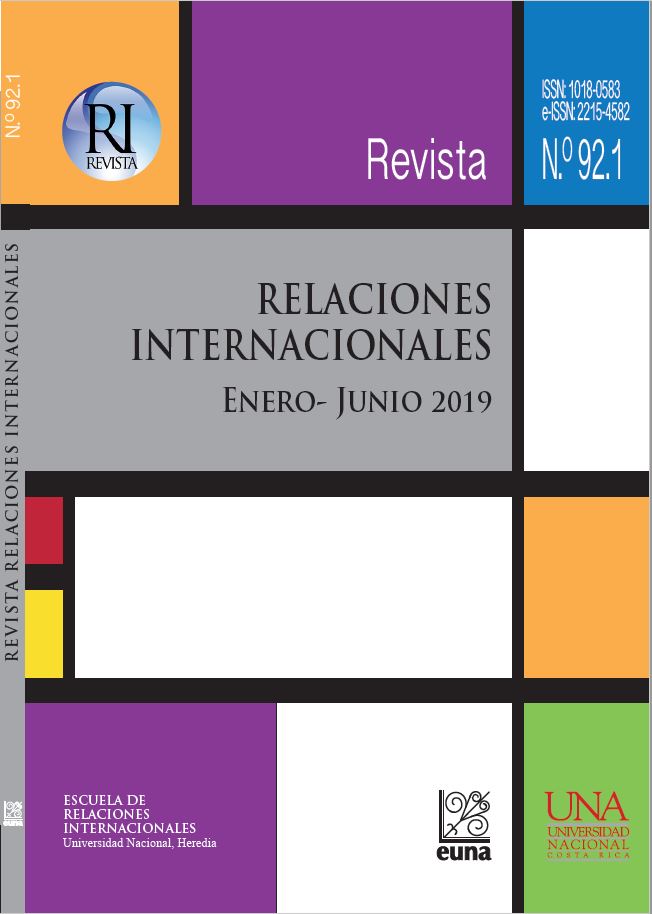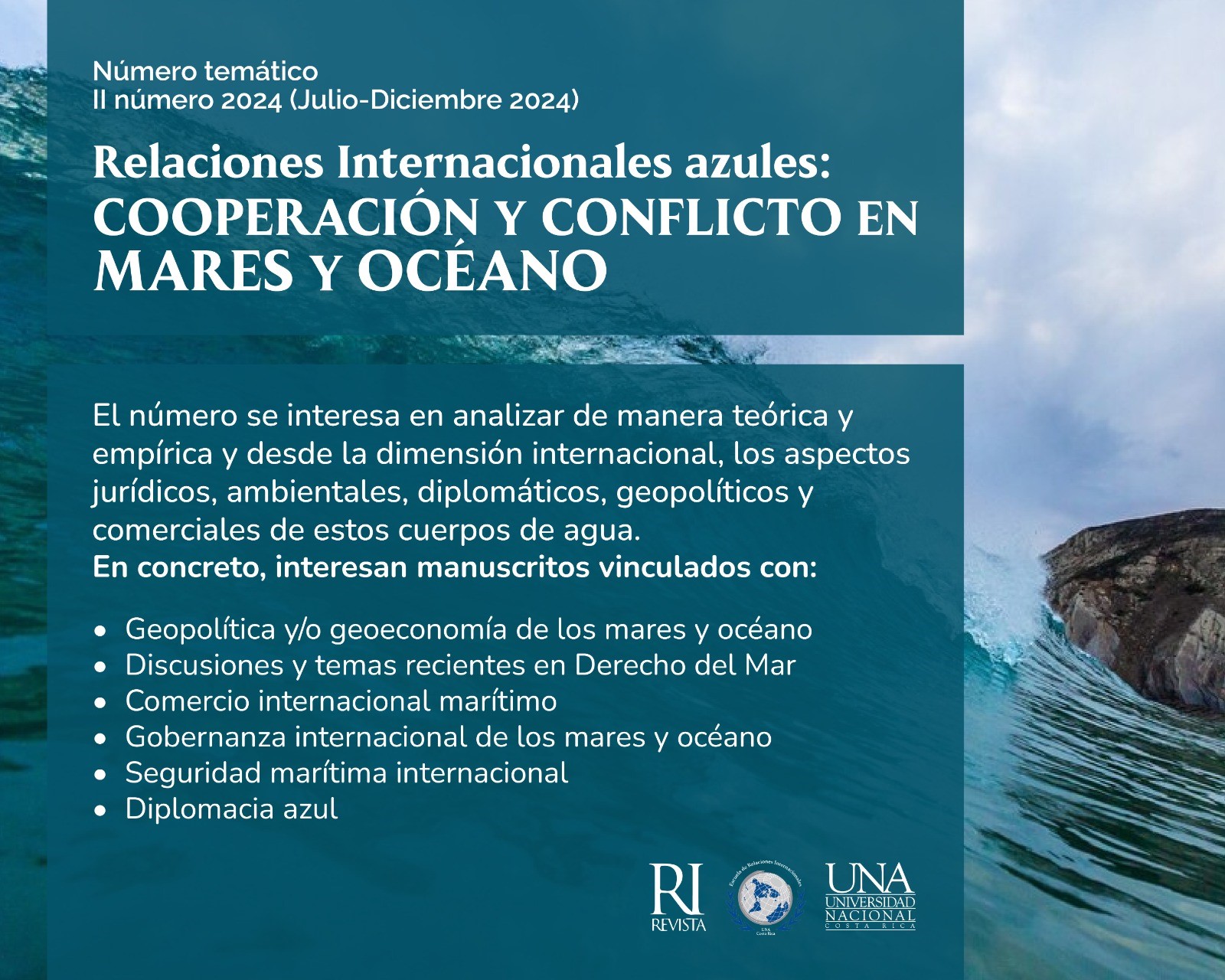Contrarrestando discursos de odio contra migrantes: Una evaluación de tratados internacionales de derechos humanos e instrumentos de derecho blando
DOI:
https://doi.org/10.15359/ri.92-1.5Palabras clave:
Derechos humanos, libertad de expresión, discursos de odio, migrantes, refugiados, Naciones UnidasResumen
Desde la crisis de refugiados en el 2015, los discursos de odio contra refugiados y migrantes han aumentado significativamente, generando preocupación en las Naciones Unidas. A pesar de que no existe una definición en el derecho internacional para los conceptos de discurso de odio o xenofobia, disposiciones en tratados de derechos humanos y en derecho blando indican un deber de los Estados de proteger a migrantes frente a discursos de odio. Haciendo una revisión de tratados de derechos humanos, documentos de organismos emanados de dichos tratados y otros instrumentos de derecho blando, este artículo busca demostrar que el discurso de odio contra migrantes debería ser sancionado por ley, ya que no entra dentro del espectro del derecho a la libertad de expresión.
Referencias
Additional protocol concerning the criminalization of acts of a racist and xenophobic nature committed through computer systems to the Convention on Cybercrime (2003) ETS No 189.
African Charter on Human and Peoples’ Rights (ACHPR), opened for signatures 27 June 1981, 21 ILM 58 (entered into force 21 October 1986).
Alston, Philip (2001). The historical origins of the concept of ‘General Comments’ in human rights law. In Boisson de Chazournes, Laurence and Gowland-Debbas, Vera (eds.) The International Legal System, In Search of Equality and Universality. Alphen aan den Rijn, Netherlands: Kluwer Law International.
American Convention on Human Rights (ACHR), 22 of November 1969, 1144 UNTS 143 (entered into force 18 July 1978).
Article 19 (2015). ‘Hate Speech’ Explained, A toolkit. London, United Kingdom: Article 19.
Benesch, Susan (2014). Defining and diminishing hate speech. In Grant, Peter (ed) State of the World’s Minorities and Indigenous Peoples 2014. London, United Kingdom: Minority Rights Group International.
Bertoni, Eduardo and Rivera Jr., Julio (2012). “The American Convention on Human Rights. Regulation of Hate Speech and Similar Expression.” In Herz, Michael and Molnar, Peter (eds), The content and context of hate speech: rethinking regulation and responses. Cambridge, United Kingdom: Cambridge University Press.
Betz, Hans-Georg and Johnson, Carol (2004). Against the current—stemming the tide: the nostalgic ideology of the contemporary radical populist right. Journal of Political Ideologies (9) pp. 311-327.
Bossuyt, Marc (1987). Guide to the “Travaux Préparatoires” of the International Covenant on Civil and Political Rights. Leiden, Netherlands: Martinus Nijhoff Publishers.
Chinkin, Christine (2014) Sources. In Moeckli, Daniel, Shah, Sangeeta and Sivakumaran, Sandesh, International Human Rights Law (2nd edition). Oxford, United Kingdom: Oxford University Press.
Clooney, Amal and Webb, Philippa (2017). The Right to Insult in International Law. Columbia Human Rights Law Review (48), pp. 1-55.
Committee on the Elimination of Racial Discrimination (CERD) (1993). General Recommendation No. 15 On Article 4 of the Convention (17 March). UN Doc CERD/GEC/7478/E._____ (2002). General Recommendation No. 30 (1 October). UN Doc CERD/C/64/Misc.11/rev.3._____ (2013) General Recommendation No. 35: Combating Racist Hate Speech (26 September). UN Doc CERD/C/GC/35.
Convention for the Protection of Human Rights and Fundamental Freedoms (ECHR), adopted 4 November 1950, 213 UNTS 221 (entered into force 3 September 1953).
Convention on the Prevention and Punishment of the Crime of Genocide (CPPCG), adopted 9 December 1948, 78 UNTS 277 (entered into force 12 January 1951).
Council of Europe (CoE) (1997). Recommendation of the Committee of Ministers to Member States on “Hate Speech,”’ (adopted 30 October 1997) No. R (97) 20.
_____ (2003). Additional protocol concerning the criminalization of acts of a racist and xenophobic nature committed through computer systems to the Convention on Cybercrime, adopted 28 January 2003, ETS No. 189 (entered into force 3 March 2006).
_____ (2006). Parliamentary Assembly Recommendation on Freedom of Expression and Respect for Religious Belief (adopted 28 June 2006) No. 1510.
_____ (2007). Parliamentary Assembly Recommendation on Blasphemy, religious insults and hate speech against persons on grounds of their religion, (adopted 29 June 2007) No. 1805.
Deng, Adama (2019). Closing remarks. In The Second Global Summit on Religion, Peace and Security. Conference conducted at the Palais de Nations, Geneva.
Durban Declaration and Plan of Action (DDPA), adopted at the World Conference Against Racism, Racial Discrimination (8 September 2001). Retrieved from http://www.un.org/WCAR/durban.pdf.
European Commission (2016). Code of conduct on countering illegal online hate speech (31 May). Retrieved from http://ec.europa.eu/justice/fundamental-rights/files/hate_speech_code_of_conduct_en.pdf.
European Commission against Racism and Intolerance (ECRI) (2002). General Policy Recommendation on National Legislation to Combat Racism and Racial Discrimination, (adopted 13 December 2002) No. 7.
_____ (2015). General Policy Recommendation on Combating Hate Speech, (adopted 8 December 2015) No. 15.
_____ (2017). Annual Report on ECRI’s activities covering the period from 1 January to 31 December 2016. Strasbourg, France: ECRI Secretariat.
European Council (2008). Council Framework Decision (EC) 2008/913/JHA on combating certain forms of racism and xenophobia by means of criminal law, OJ L 328/56.
European Union (2015). Joint Communication: Addressing the Refugee Crisis in Europe: The Role of EU External Action, JOIN/2015/0040.
Gaeta, Paola (2011). Genocide. In Schabas, William A. and Bernaz, Nadia (eds) Routledge Handbook of International Criminal Law. London, United Kingdom: Routledge.
Ghanea, Nazila (2013). Intersectionality and the Spectrum of Racist Hate Speech: Proposals to the UN Committee on the Elimination of Racial Discrimination. Human Rights Quarterly (35) pp. 935-954.
Interamerican Convention Against Racism, Racial Discrimination and Related Forms of Intolerance (Convention Against Racism), adopted 5 June, 2013, T.S. No. A-68 (entered into force 11 November, 2017).
International Convention on the Elimination of All Forms of Racial Discrimination (ICERD), opened for signatures 21 December 1965, 660 UNTS 195 (entered into force 4 January 1969).
International Covenant on Civil and Political Rights (ICCPR), adopted 16 December 1966, 999 UNTS 171 (entered into force 23 March 1976).
Legesse Mengistu, Yared (2012). “Shielding Marginalized Groups from Verbal Assaults Without Abusing Hate Speech Laws.” In Herz, Michael and Molnar, Peter (eds), The content and context of hate speech: rethinking regulation and responses. Cambridge, United Kingdom: Cambridge University Press.
Lerner, Natan (2015). The UN Convention on the Elimination of All Forms of Racial Discrimination. Leiden, Netherlands: Brill Nijhoff.
Mannecke, Martin (2012). Sixty Years of the UN Genocide Convention – New Challenges for Genocide Education. In Van der Wilt, H.G., Vervliet, J., Sluiter, G.K. and Houwink ten Cate, J.T. (eds) The Genocide Convention, The Legacy of 60 Years. Leiden, Netherlands: Martinus Nihjof Publishers.
Maynar, Jonathan L. and Benesech, Susan (2016). Dangerous Speech and Dangerous Ideology: An Integrated Model for Monitoring and Prevention. Genocide Studies and Prevention: An International Journal (9) pp. 70-95.
Muižnieks, Nils (2014). ‘Hate speech against women should be specifically tackled’ Council of Europe. Retrieved from https://www.coe.int/.
Nowak, Manfred (2005). U.N. Covenant on Civil and Political Rights, CCPR Commentary. Kehl am Rhein, Germany: NP Engel Verlag.
Office of the United Nations High Commissioner for Human Rights (OHCHR) (2006). The Rights of Non-Citizens. New York, United States: United Nations Publications.
O’Flaherty, Michael (2015). International Covenant on Civil and Political Rights: Interpreting Freedom of Expression and Information Standards for the Present and the Future. In McGonagle, Tarlach and Donders, Yvonne (eds) The United Nations and Freedom of Expression and Information, Critical Perspectives. Cambridge, United Kingdom: Cambridge University Press.
Organization of American States (2004). Annual Report of the Office of the Special Rapporteur for Freedom of Expression. Retrieved from http://www.oas.org/.
Rabat Plan of Action - Report of the United Nations High Commissioner for Human Rights on the expert workshops on the prohibition of incitement to national, racial or religious hatred (11 January 2013). UN Doc A/HRC/22/17/Add.4.
Shelton, Dinah (2012). The Legal Status of Normative Pronouncements of Human Rights Treaty Bodies. In Hestermeyer Holger P. and others (eds.), Coexistence, Cooperation and Solidarity: Liber Amicorum Rüdiger Wolfrum, Volume 1. Leiden, Netherlands: Martinus Nijhoff Publishers.
Southwick, Katherine (2015). Preventing mass atrocities against the stateless Rohingya in Myanmar: A call for solutions. Columbia Journal of International Affairs (68) pp. 137-156.
United Nations (2019). Concept Note: The Second Global Summit on Religion Peace and Security. Building bridges, fostering inclusivity and countering hate speech to enhance the protection of religious minorities, refugees and migrants. Retrieved from https://www.unog.ch/.
United Nations General Assembly (UNGA) (19 september, 2016). New York Declaration for Refugees and Migrants. UN Doc A/RES/71/1.
United Nations Human Rights Committee (HRComm) (1983). General Comment No. 11: Article 20. Retrieved from http://tbinternet.ohchr.org/.
_____ (2011). General Comment No. 34, Article 19: Freedoms of opinion and expression. UN Doc CCPR/C/GC/34.
United Nations Human Rights Council (UNHRC) (2012). Combating intolerance, negative stereotyping and stigmatization of, and discrimination, incitement to violence and violence against, persons based on religion or belief (12 April 2012). UN Doc A/HRC/RES/16/18.
Van Blarcum, Christopher D. (2005). Internet Hate Speech: The European Framework and the Emerging American Haven. Washington and Lee Law Review (62) pp. 781-830.
Vienna Convention on the Law of Treaties, adopted 23 May 1969, 1155 UNTS 331 (entered into force 27 January 1980).
Waldron, Jeremy (2006, 20 July). Boutique Faith. London Review of Books (28), pp. 22-23.
Wieviorka, Michel (2010). Racism in Europe. In Martiniello, Marco and Rath, Jan (eds) Selected Studies in International Migration and Immigrant Incorporation, Amsterdam, Netherlands: Amsterdam University Press.
Wimmer, Andreas (1997). Explaining xenophobia and racism: A critical review of current research approaches. Ethnic and Racial Studies (20) pp. 17-41.
Descargas
Publicado
Cómo citar
Número
Sección
Licencia
Esta publicación está adscrita a Creative Commons; deben respetarse sus atribuciones y restricciones.
Los autores/as que publiquen en esta revista aceptan las siguientes condiciones:
- Los autores/as conservan los derechos de autor y ceden a la revista el derecho de la primera publicación, con el trabajo registrado con la Licencia Creative Commons Atribución-NoComercial-CompartirIgual 4.0 Internacional, que permite a terceros utilizar lo publicado siempre que mencionen la autoría del trabajo y a la primera publicación en esta revista.
- Los autores/as pueden realizar otros acuerdos contractuales independientes y adicionales para la distribución no exclusiva de la versión del artículo publicado en esta revista (p. ej., incluirlo en un repositorio institucional o publicarlo en un libro) siempre que indiquen claramente que el trabajo se publicó por primera vez en esta revista.
- Se permite y recomienda a los autores/as a publicar su trabajo en Internet (por ejemplo en páginas institucionales o personales) antes y durante el proceso de revisión y publicación, ya que puede conducir a intercambios productivos y a una mayor y más rápida difusión del trabajo publicado.
Revista de Relaciones Internacionales por Universidad Nacional de Costa Rica está bajo una Licencia Creative Commons Atribución-NoComercial-SinDerivar 4.0 Internacional









.png)



2.png)
